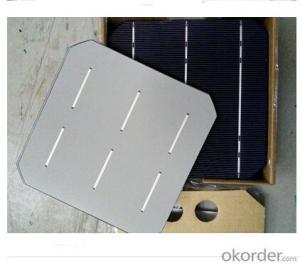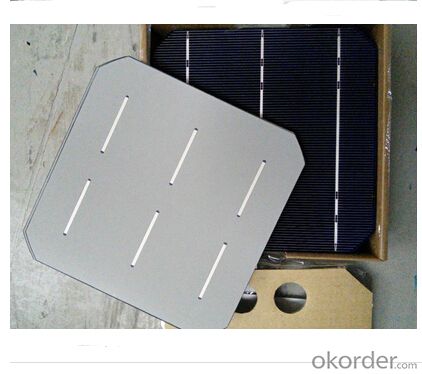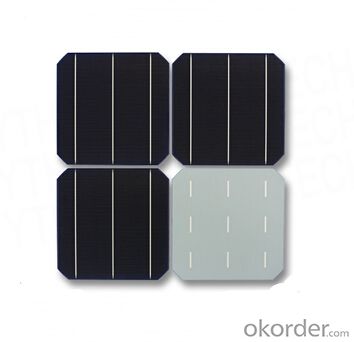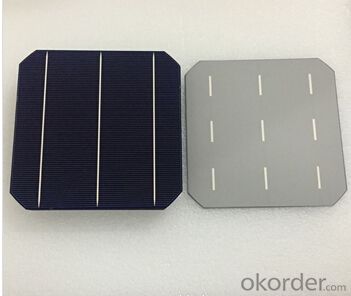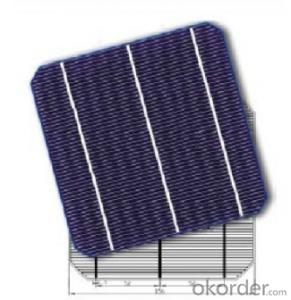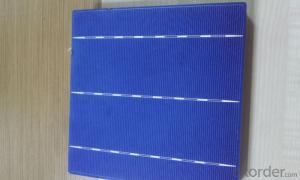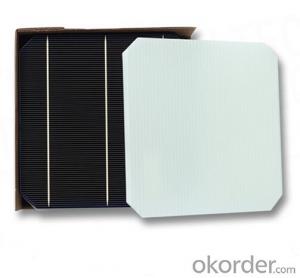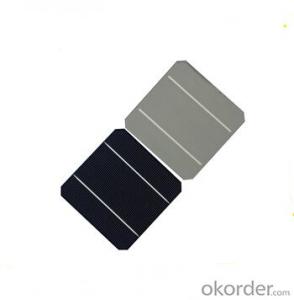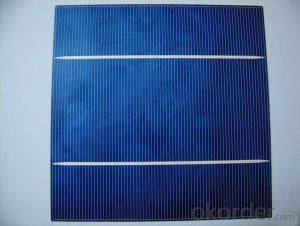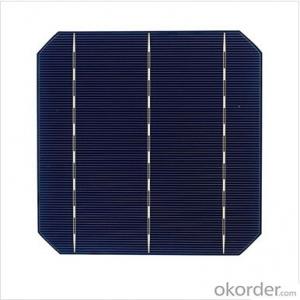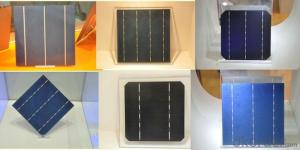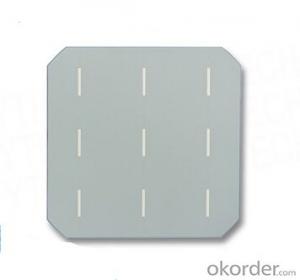Topcon A Grade 16.6% Monocrystalline Solar Cells
- Loading Port:
- Shanghai
- Payment Terms:
- TT OR LC
- Min Order Qty:
- 5000 pc
- Supply Capability:
- 80000 pc/month
OKorder Service Pledge
OKorder Financial Service
You Might Also Like
Monocrystalline Solar Cells A GRADE:
Solar cells is made by solar wafer, it has three categories of solar cell right now, monocrystalline polycrystalline and thin film,These cells are entirely based around the concept of ap-n junction, which is the critical part of solar module, it is the part that can convert the light energy into electricity, the thickness is from 180um to 200um, with even busbars to conduct electricity, textured cell can decrease diffuse reflection; they are often electrically connected and encapsulated as a module. Photovoltaic modules often have a sheet of glass on the front (sun up) side, allowing light to pass while protecting semiconductor wafers from abrasion and impact due to wind-driven debris, rain, hail, etc. Solar cells are also usually connected in series in modules, creating an additive voltage. Connecting cells in parallel will yield a higher current;With high quality and stable quality. Our Cells can greatly improve the performance of Solar Modules.
Monocrystalline Silicon Solar Cells A GRADE Advantage:
• High efficiency and stable performance in photovoltaic conversion.
• Advanced diffusion technique ensuring the homogeneity of energy conversion efficiency of the cell.
• Advanced PECVD film forming, providing a dark blue silicon nitride anti-reflection film of homogenous color and attractive appearance.
• High quality metal paste for back surface and electrode, ensuring good conductivity, high pulling strength and ease of soldering.
• High precision patterning using screen printing, ensuring accurate busbar location for ease with automatic soldering a laser cutting.
Specifications of Monocrystalline Solar Cells
Efficiency (%) Pmpp (W) Umpp (V) Impp (A) Uoc (V) Isc (A) |
18.20% 4.43 0.536 8.263 0.634 8.712 |
18.00% 4.38 0.535 - 8.188 0.633 8.701 |
17.80% - 4.33 0.534 - -8.112 ---0.632 ----8.652 |
17.60% 4.28 0.533 8.036 0.631 8.641 |
17.40% 4.23 0.529 8.005 0.630 8.591 |
17.20% 4.19 0.525 7.973 0.627 8.542 |
17.00% 4.14 0.522 7.926 0.624 8.495 |
16.80% 4.09 0.518 7.893 0.620 8.452 |
16.60% 4.04 0.515 7.844 0.617 8.410 |
Monocrystalline Solar Cells
Solar cells are often electrically connected and encapsulated as a module. Photovoltaic modules often have a sheet of glass on the front (sun up) side, allowing light to pass while protecting the semiconductor wafers from abrasion and impact due to wind-driven debris, rain, hail, etc. Solar cells are also usually connected in series in modules, creating an additive voltage. Connecting cells in parallel will yield a higher current; our solar cells have passed IEC Certification. With high and stable quality, our cells can greatly improve the performance of Solar Modules.
Applications of Monocrystalline Solar Cells
Assemblies of photovoltaic cells are used to make solar modules which generate electrical power from sunlight, as distinguished from a "solar module" or "solar panel". A solar array generates solar power using solar energy.

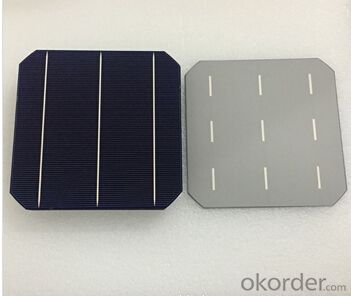
FAQ
We have organized several common questions for our clients,may help you sincerely:
①What price for each watt?
It depends on the efficiency of the solar cell, quantity, delivery date and payment terms.
②How long can we receive the product after purchase?
In the purchase of product within three working days, We will arrange the factory delivery as soon as possible. The pecific time of receiving is related to the state and position of customers.Commonly 7 to 10 working days can be served.
③Can you provide the peripheral products of the solar panels, such as the battery, controller, and inverter? If so, can you tell me how do they match each other?
Yes, we can, we have two companies for solar region, one is CNBM International, the other is CNBM engineering Co.
We can provide you not only the solar module but also the off grid solar system, we can also provide you service with on grid plant.
④What is your warranty of solar cell?
Our product can promise lower than 0.3% open box crack, we support claim after opening the box if it has crackm color difference or sth, the buyer should give pictures immediately, we can not accept the claim after the solar cell has assembled to solar panel.
• Timeliness of delivery
• ⑤How do you pack your products?
We have rich experience on how to pack the solar cell to make sure the safety on shipment, we could use wooden box or pallet as buyer's preference.
⑥ Can you do OEM for us?
Yes, we can.
- Q: Can solar cells be used in ski resorts for snowmaking?
- Yes, solar cells can be used in ski resorts for snowmaking. Solar panels can generate electricity from sunlight, which can then be used to power snowmaking equipment. This can provide a sustainable and environmentally friendly solution for snowmaking, reducing the reliance on traditional energy sources.
- Q: How do solar cells perform in regions with frequent thunderstorms?
- Solar cells are not directly affected by thunderstorms themselves. However, frequent thunderstorms in a region can lead to reduced sunlight exposure, which may affect the overall performance of solar cells.
- Q: Can solar cells be used to power off-grid cabins or homes?
- Yes, solar cells can be used to power off-grid cabins or homes. Solar cells, also known as photovoltaic cells, convert sunlight into electricity. They can be installed on the roof or in a sunny location to capture solar energy. This energy can be stored in batteries for use during nighttime or cloudy days when there is less sunlight. With advancements in technology, solar cells have become more efficient and affordable, making them a popular choice for off-grid living.
- Q: Can solar cells be damaged by hail or strong winds?
- Yes, solar cells can be damaged by hail or strong winds. Hailstones can impact and crack the surface of the solar panels, impairing their efficiency or causing complete failure. Similarly, strong winds can potentially dislodge or break the panels, leading to damage or displacement. It is important to ensure proper installation and maintenance to protect solar cells from these potential hazards.
- Q: Can solar cells be used for large-scale power generation?
- Yes, solar cells can certainly be used for large-scale power generation. They have the potential to harness abundant sunlight and convert it into electricity on a massive scale. As technology and efficiency of solar cells continue to improve, they are increasingly being deployed in utility-scale solar farms, providing a sustainable and renewable source of power to meet the growing energy demands of our society.
- Q: What is the typical lifespan of a solar cell?
- The typical lifespan of a solar cell is around 25 to 30 years.
- Q: Can solar cells be used in telecommunications systems?
- Yes, solar cells can be used in telecommunications systems. Solar cells are capable of converting sunlight into electricity, which can power various telecommunications equipment such as base stations, repeaters, and remote monitoring systems. This allows for reliable and independent power supply in remote areas or during power outages, making solar cells an energy-efficient and sustainable solution for telecommunications systems.
- Q: How do solar cells perform in areas with frequent hurricanes?
- Solar cells can still perform well in areas with frequent hurricanes, provided they are designed and installed with specific considerations in mind. Reinforced mounting systems, robust construction materials, and proper installation techniques can enhance the durability of solar panels against strong winds and debris. Additionally, grid-connected solar systems with battery storage can provide reliable power during power outages caused by hurricanes, making them a resilient energy solution for such areas.
- Q: Can solar cells be used in marine applications?
- Yes, solar cells can be used in marine applications. They can be integrated into boats, yachts, and other marine vessels to generate electricity from sunlight, which can be used to power various onboard systems and equipment. Additionally, solar cells can also be used to charge batteries, providing a reliable and sustainable source of energy for marine applications.
- Q: How do solar cells handle electromagnetic interference?
- Solar cells are designed to handle electromagnetic interference by incorporating shielding techniques such as grounded enclosures and filtering components. This helps to minimize the impact of electromagnetic waves and ensure uninterrupted power generation.
Send your message to us
Topcon A Grade 16.6% Monocrystalline Solar Cells
- Loading Port:
- Shanghai
- Payment Terms:
- TT OR LC
- Min Order Qty:
- 5000 pc
- Supply Capability:
- 80000 pc/month
OKorder Service Pledge
OKorder Financial Service
Similar products
Hot products
Hot Searches
Related keywords
